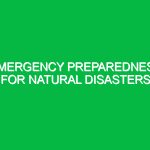Public infrastructure projects play a crucial role in the development and sustainability of communities. From roads and bridges to water supply systems, these projects require careful planning and execution. However, amidst the hustle and bustle of construction, the significance of health, safety, and environmental (HSE) considerations cannot be overstated. In this article, we will explore the safety considerations for public infrastructure projects, looking at potential hazards, safety precautions, best practices, and relevant regulations that guide these endeavors.
Understanding Safety Considerations in Public Infrastructure Projects
When we talk about safety considerations for public infrastructure projects, we refer to the systematic approach to managing risks associated with construction activities. This involves identifying potential hazards, assessing the risks, and implementing measures to mitigate them. The goal is to ensure that the project is executed with minimal impact on workers, the public, and the environment.
The relevance of safety considerations in the HSE domain is profound. According to the Occupational Safety and Health Administration (OSHA), construction sites are among the most dangerous workplaces, with numerous incidents occurring due to negligence or lack of foresight. Thus, integrating robust safety measures from the onset can save lives, reduce project delays, and prevent costly legal repercussions.
Identifying Potential Hazards and Risks
Public infrastructure projects encounter a myriad of hazards, some of which may not be immediately apparent. Recognizing these risks is the first step in ensuring safety. Here are some common hazards associated with such projects:
1. Physical Hazards
Physical hazards include slips, trips, and falls, which are among the most frequent causes of injuries on construction sites. Uneven surfaces, wet conditions, and cluttered work areas can all contribute to these incidents. A personal anecdote from my time working on a highway expansion project comes to mind. One day, a worker slipped on a wet surface, resulting in a minor injury that could have been avoided with better housekeeping practices.
2. Mechanical Hazards
Heavy machinery is a staple in public infrastructure projects, but it comes with its own set of risks. Equipment malfunctions, improper use, and lack of maintenance can lead to severe accidents. For example, the collapse of a crane during a bridge construction project in 2017 serves as a tragic reminder of the importance of regular equipment inspections and proper operator training.
3. Chemical Hazards
Many construction materials pose chemical hazards, including asbestos, lead, and various solvents. Workers handling these substances without appropriate personal protective equipment (PPE) face serious health risks. In an incident reported by the National Institute for Occupational Safety and Health (NIOSH), workers exposed to lead dust during renovation projects experienced long-term health issues due to inadequate safety protocols.
4. Biological Hazards
Public infrastructure sites can also expose workers to biological hazards, such as mold, bacteria, and even pests. For instance, a water system upgrade may uncover stagnant water sources that harbor harmful microorganisms. Proper sanitation and health screenings can mitigate these risks, but awareness is key.
5. Environmental Hazards
Environmental hazards, including extreme weather conditions and exposure to natural elements, can disrupt construction activities and endanger workers. A sudden storm can not only halt work but also create hazardous conditions through flooding or debris. Having an emergency response plan in place is essential to navigate such unpredictable situations.
Best Practices for Safety Precautions
Once hazards are identified, the next step is to implement effective safety precautions. Here are several best practices that can enhance safety considerations for public infrastructure projects:
1. Conduct Comprehensive Risk Assessments
Risk assessments should be conducted before any construction begins. This involves evaluating the site, identifying potential hazards, and determining the likelihood and severity of incidents. Regular updates to the assessment are necessary as conditions change throughout the project lifecycle.
2. Implement Training and Education Programs
Workers should receive thorough training on safety protocols, equipment use, and emergency response procedures. For instance, OSHA mandates that workers operating heavy machinery undergo specific training to ensure they can identify and mitigate risks effectively. Education empowers workers to make safer choices on-site.
3. Utilize Personal Protective Equipment (PPE)
PPE is crucial in protecting workers from various hazards. Hard hats, safety goggles, gloves, and high-visibility clothing should be mandatory on construction sites. A personal experience I had during a trenching project highlights this point; proper PPE prevented what could have been a serious head injury when a tool fell unexpectedly.
4. Promote a Safety Culture
Creating a workplace culture that prioritizes safety can have a profound impact. Encouraging open communication about safety concerns and recognizing safe practices fosters an environment where workers feel responsible for their own safety and that of their peers.
5. Establish Emergency Response Plans
Every public infrastructure project should have a clear emergency response plan. This plan should outline procedures for various scenarios, including severe weather, hazardous material spills, or accidents. Regular drills can ensure that workers are familiar with the protocol and can act quickly in emergencies.
Regulations and Standards Governing Safety Considerations
Adhering to regulations is paramount in ensuring the safety of public infrastructure projects. Several key regulations and standards guide safety practices in this domain:
1. Occupational Safety and Health Administration (OSHA)
OSHA provides regulations that set forth safety standards for construction sites. These include guidelines on fall protection, scaffolding safety, and regulations regarding the use of heavy machinery. Compliance with OSHA standards is not just a legal requirement; it is a commitment to the safety and well-being of all workers.
2. National Fire Protection Association (NFPA)
The NFPA sets codes and standards to minimize fire risks on construction sites. This includes regulations around fire extinguishers, flammable materials storage, and emergency exit routes. Integrating these standards into project planning can significantly reduce fire hazards.
3. Environmental Protection Agency (EPA)
The EPA outlines regulations concerning environmental safety, especially during projects that may impact air and water quality. Understanding and adhering to these regulations is vital to protecting both workers and the community.
Conclusion
Safety considerations for public infrastructure projects are not merely a checkbox on a project planner; they are the bedrock upon which successful, sustainable, and responsible construction is built. By identifying potential hazards, implementing best practices, and adhering to regulations, we can create safer working environments. As we continue to invest in infrastructure, let us prioritize health, safety, and environmental considerations to ensure that these projects serve their intended purpose without compromising safety.
In a world where public infrastructure is essential for connectivity and growth, the integration of robust safety measures is not just a responsibility but a necessity. By committing to these principles, we can pave the way for a safer future for all.


